warning DODGE DURANGO SRT 2019 Vehicle Warranty
[x] Cancel search | Manufacturer: DODGE, Model Year: 2019, Model line: DURANGO SRT, Model: DODGE DURANGO SRT 2019Pages: 270, PDF Size: 2.52 MB
Page 230 of 270
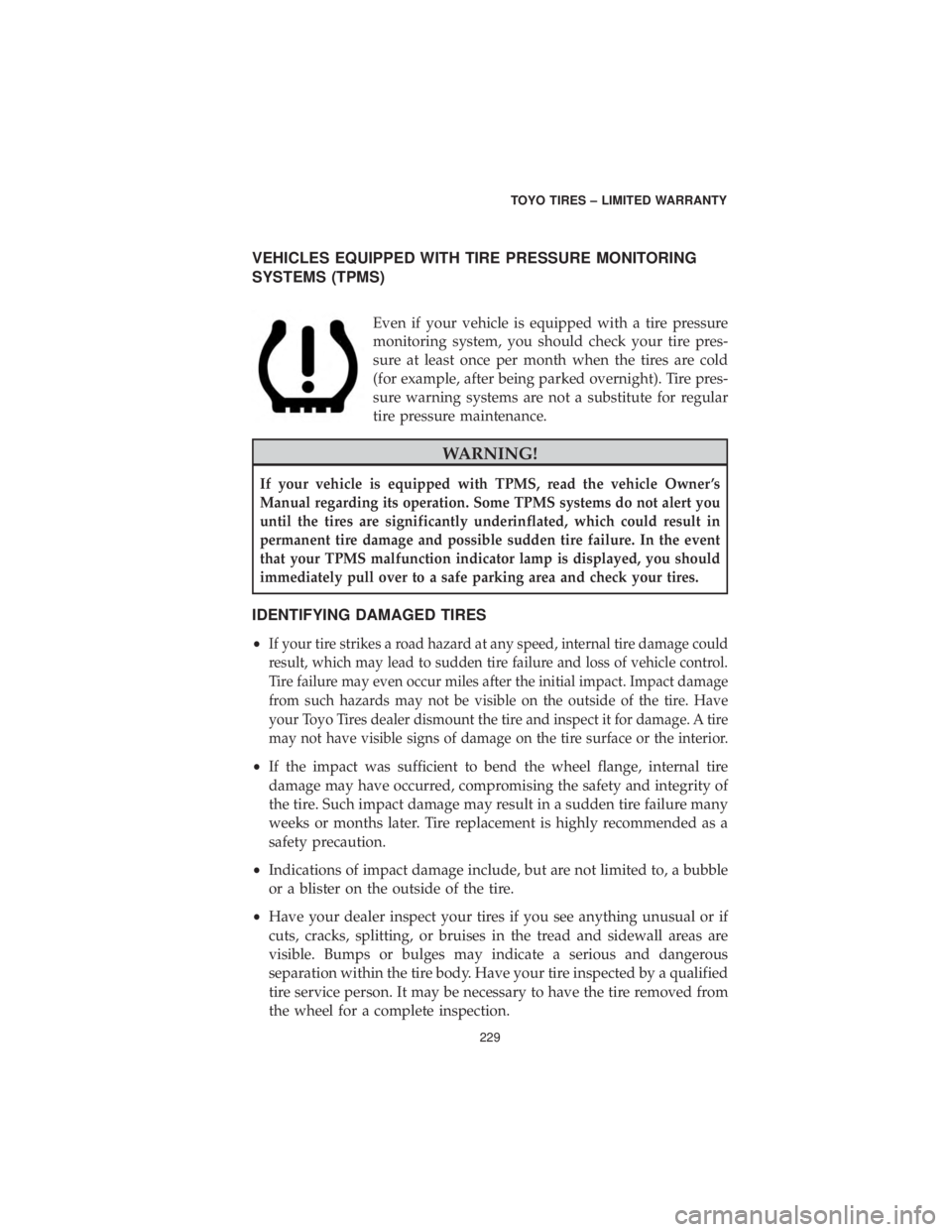
VEHICLES EQUIPPED WITH TIRE PRESSURE MONITORING
SYSTEMS (TPMS)
Even if your vehicle is equipped with a tire pressure
monitoring system, you should check your tire pres-
sure at least once per month when the tires are cold
(for example, after being parked overnight). Tire pres-
sure warning systems are not a substitute for regular
tire pressure maintenance.
WARNING!
If your vehicle is equipped with TPMS, read the vehicle Owner ’s
Manual regarding its operation. Some TPMS systems do not alert you
until the tires are significantly underinflated, which could result in
permanent tire damage and possible sudden tire failure. In the event
that your TPMS malfunction indicator lamp is displayed, you should
immediately pull over to a safe parking area and check your tires.
IDENTIFYING DAMAGED TIRES
•If your tire strikes a road hazard at any speed, internal tire damage could
result, which may lead to sudden tire failure and loss of vehicle control.
Tire failure may even occur miles after the initial impact. Impact damage
from such hazards may not be visible on the outside of the tire. Have
your Toyo Tires dealer dismount the tire and inspect it for damage. A tire
may not have visible signs of damage on the tire surface or the interior.
• If the impact was sufficient to bend the wheel flange, internal tire
damage may have occurred, compromising the safety and integrity of
the tire. Such impact damage may result in a sudden tire failure many
weeks or months later. Tire replacement is highly recommended as a
safety precaution.
• Indications of impact damage include, but are not limited to, a bubble
or a blister on the outside of the tire.
• Have your dealer inspect your tires if you see anything unusual or if
cuts, cracks, splitting, or bruises in the tread and sidewall areas are
visible. Bumps or bulges may indicate a serious and dangerous
separation within the tire body. Have your tire inspected by a qualified
tire service person. It may be necessary to have the tire removed from
the wheel for a complete inspection.
TOYO TIRES – LIMITED WARRANTY
229
Page 231 of 270
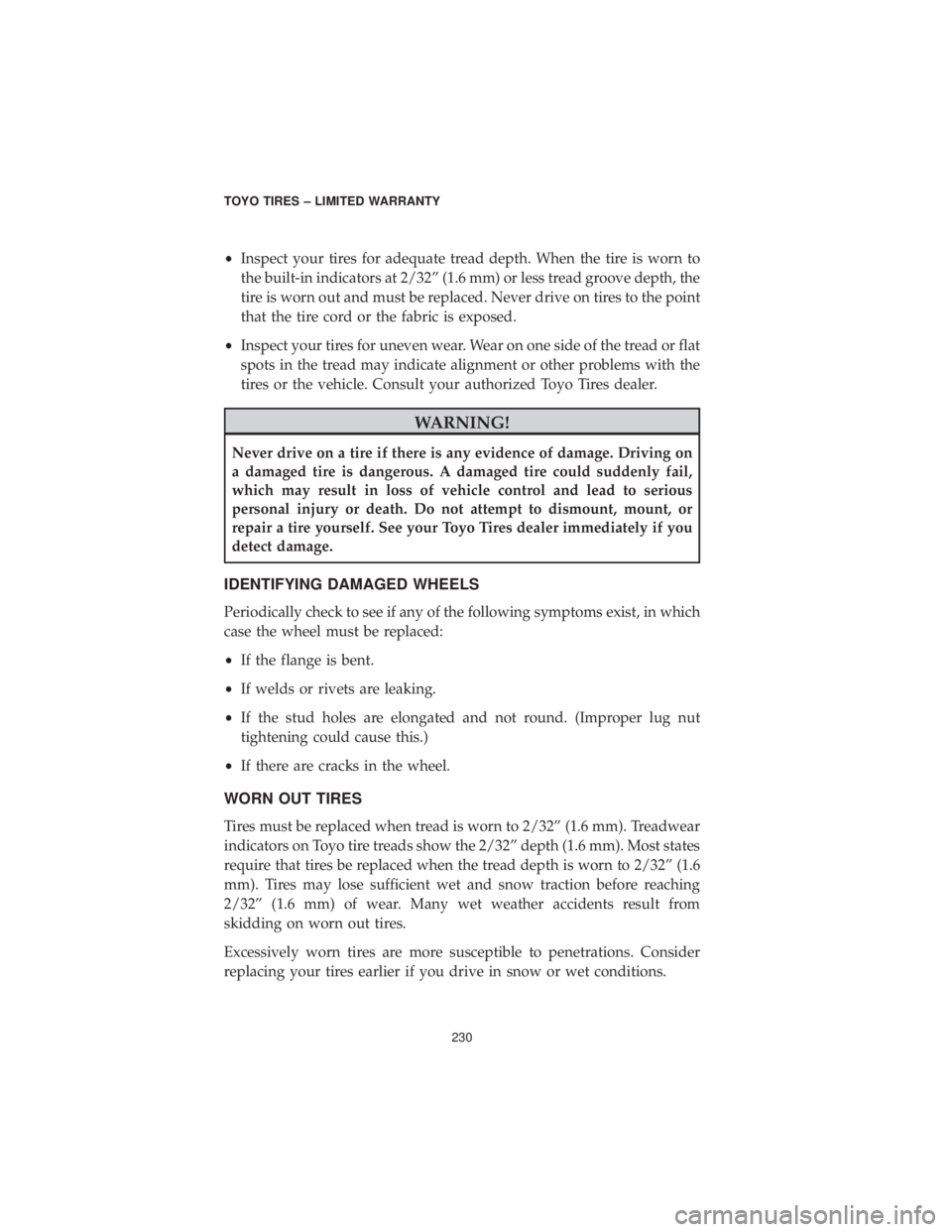
•Inspect your tires for adequate tread depth. When the tire is worn to
the built-in indicators at 2/32” (1.6 mm) or less tread groove depth, the
tire is worn out and must be replaced. Never drive on tires to the point
that the tire cord or the fabric is exposed.
• Inspect your tires for uneven wear. Wear on one side of the tread or flat
spots in the tread may indicate alignment or other problems with the
tires or the vehicle. Consult your authorized Toyo Tires dealer.
WARNING!
Never drive on a tire if there is any evidence of damage. Driving on
a damaged tire is dangerous. A damaged tire could suddenly fail,
which may result in loss of vehicle control and lead to serious
personal injury or death. Do not attempt to dismount, mount, or
repair a tire yourself. See your Toyo Tires dealer immediately if you
detect damage.
IDENTIFYING DAMAGED WHEELS
Periodically check to see if any of the following symptoms exist, in which
case the wheel must be replaced:
• If the flange is bent.
• If welds or rivets are leaking.
• If the stud holes are elongated and not round. (Improper lug nut
tightening could cause this.)
• If there are cracks in the wheel.
WORN OUT TIRES
Tires must be replaced when tread is worn to 2/32” (1.6 mm). Treadwear
indicators on Toyo tire treads show the 2/32” depth (1.6 mm). Most states
require that tires be replaced when the tread depth is worn to 2/32” (1.6
mm). Tires may lose sufficient wet and snow traction before reaching
2/32” (1.6 mm) of wear. Many wet weather accidents result from
skidding on worn out tires.
Excessively worn tires are more susceptible to penetrations. Consider
replacing your tires earlier if you drive in snow or wet conditions.
TOYO TIRES – LIMITED WARRANTY
230
Page 232 of 270
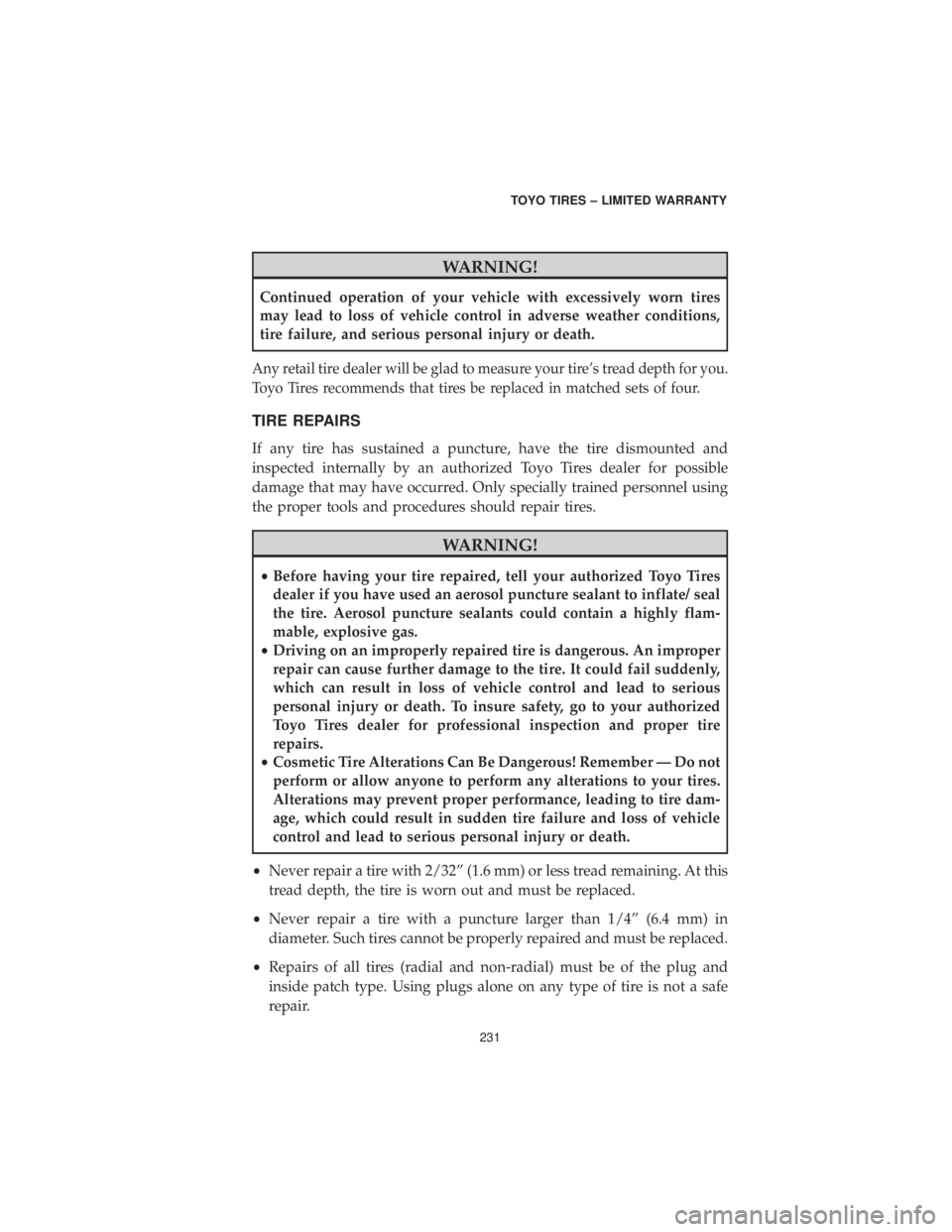
WARNING!
Continued operation of your vehicle with excessively worn tires
may lead to loss of vehicle control in adverse weather conditions,
tire failure, and serious personal injury or death.
Any retail tire dealer will be glad to measure your tire’s tread depth for you.
Toyo Tires recommends that tires be replaced in matched sets of four.
TIRE REPAIRS
If any tire has sustained a puncture, have the tire dismounted and
inspected internally by an authorized Toyo Tires dealer for possible
damage that may have occurred. Only specially trained personnel using
the proper tools and procedures should repair tires.
WARNING!
•Before having your tire repaired, tell your authorized Toyo Tires
dealer if you have used an aerosol puncture sealant to inflate/ seal
the tire. Aerosol puncture sealants could contain a highly flam-
mable, explosive gas.
• Driving on an improperly repaired tire is dangerous. An improper
repair can cause further damage to the tire. It could fail suddenly,
which can result in loss of vehicle control and lead to serious
personal injury or death. To insure safety, go to your authorized
Toyo Tires dealer for professional inspection and proper tire
repairs.
• Cosmetic Tire Alterations Can Be Dangerous! Remember — Do not
perform or allow anyone to perform any alterations to your tires.
Alterations may prevent proper performance, leading to tire dam-
age, which could result in sudden tire failure and loss of vehicle
control and lead to serious personal injury or death.
• Never repair a tire with 2/32” (1.6 mm) or less tread remaining. At this
tread depth, the tire is worn out and must be replaced.
• Never repair a tire with a puncture larger than 1/4” (6.4 mm) in
diameter. Such tires cannot be properly repaired and must be replaced.
• Repairs of all tires (radial and non-radial) must be of the plug and
inside patch type. Using plugs alone on any type of tire is not a safe
repair.
TOYO TIRES – LIMITED WARRANTY
231
Page 235 of 270
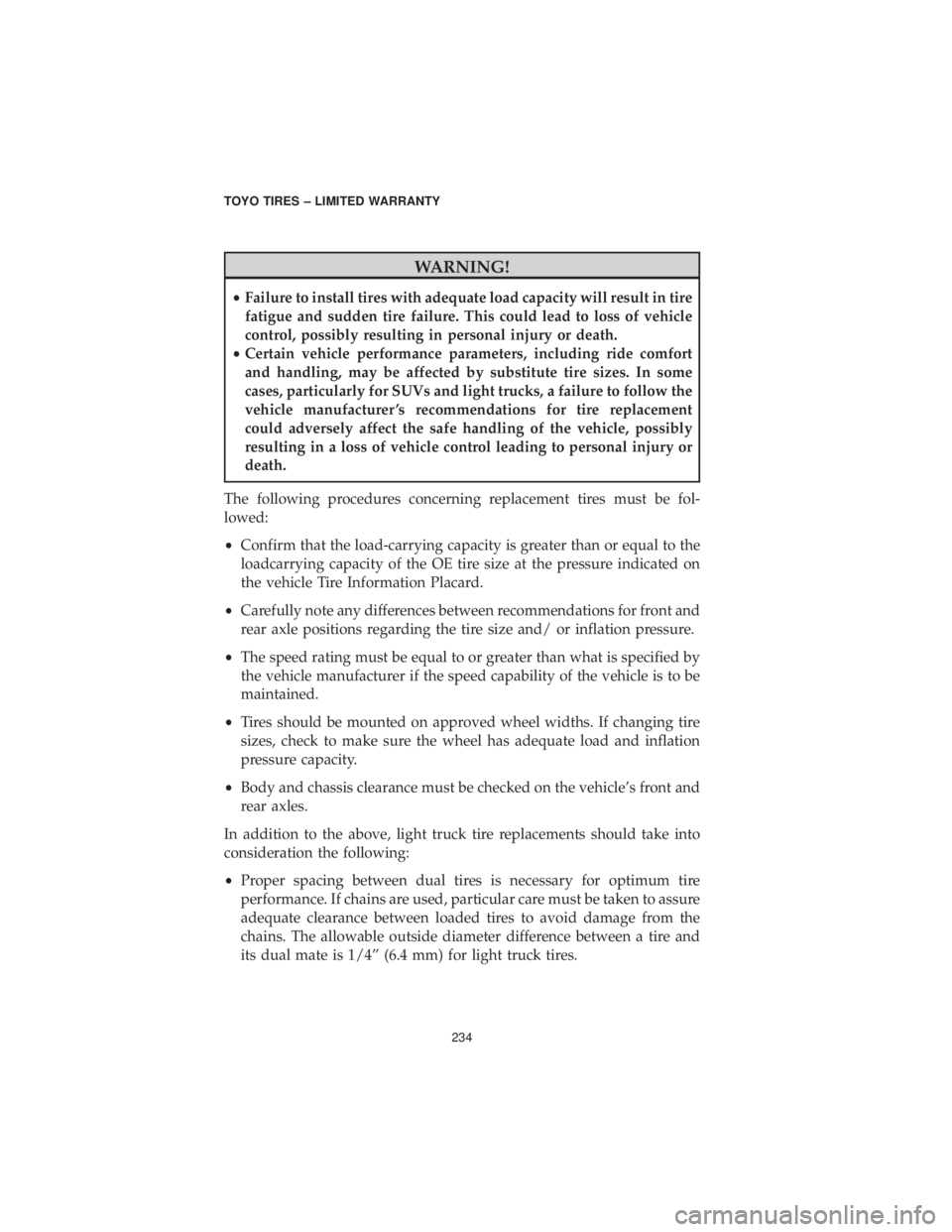
WARNING!
•Failure to install tires with adequate load capacity will result in tire
fatigue and sudden tire failure. This could lead to loss of vehicle
control, possibly resulting in personal injury or death.
• Certain vehicle performance parameters, including ride comfort
and handling, may be affected by substitute tire sizes. In some
cases, particularly for SUVs and light trucks, a failure to follow the
vehicle manufacturer ’s recommendations for tire replacement
could adversely affect the safe handling of the vehicle, possibly
resulting in a loss of vehicle control leading to personal injury or
death.
The following procedures concerning replacement tires must be fol-
lowed:
• Confirm that the load-carrying capacity is greater than or equal to the
loadcarrying capacity of the OE tire size at the pressure indicated on
the vehicle Tire Information Placard.
• Carefully note any differences between recommendations for front and
rear axle positions regarding the tire size and/ or inflation pressure.
• The speed rating must be equal to or greater than what is specified by
the vehicle manufacturer if the speed capability of the vehicle is to be
maintained.
• Tires should be mounted on approved wheel widths. If changing tire
sizes, check to make sure the wheel has adequate load and inflation
pressure capacity.
• Body and chassis clearance must be checked on the vehicle’s front and
rear axles.
In addition to the above, light truck tire replacements should take into
consideration the following:
• Proper spacing between dual tires is necessary for optimum tire
performance. If chains are used, particular care must be taken to assure
adequate clearance between loaded tires to avoid damage from the
chains. The allowable outside diameter difference between a tire and
its dual mate is 1/4” (6.4 mm) for light truck tires.
TOYO TIRES – LIMITED WARRANTY
234
Page 236 of 270
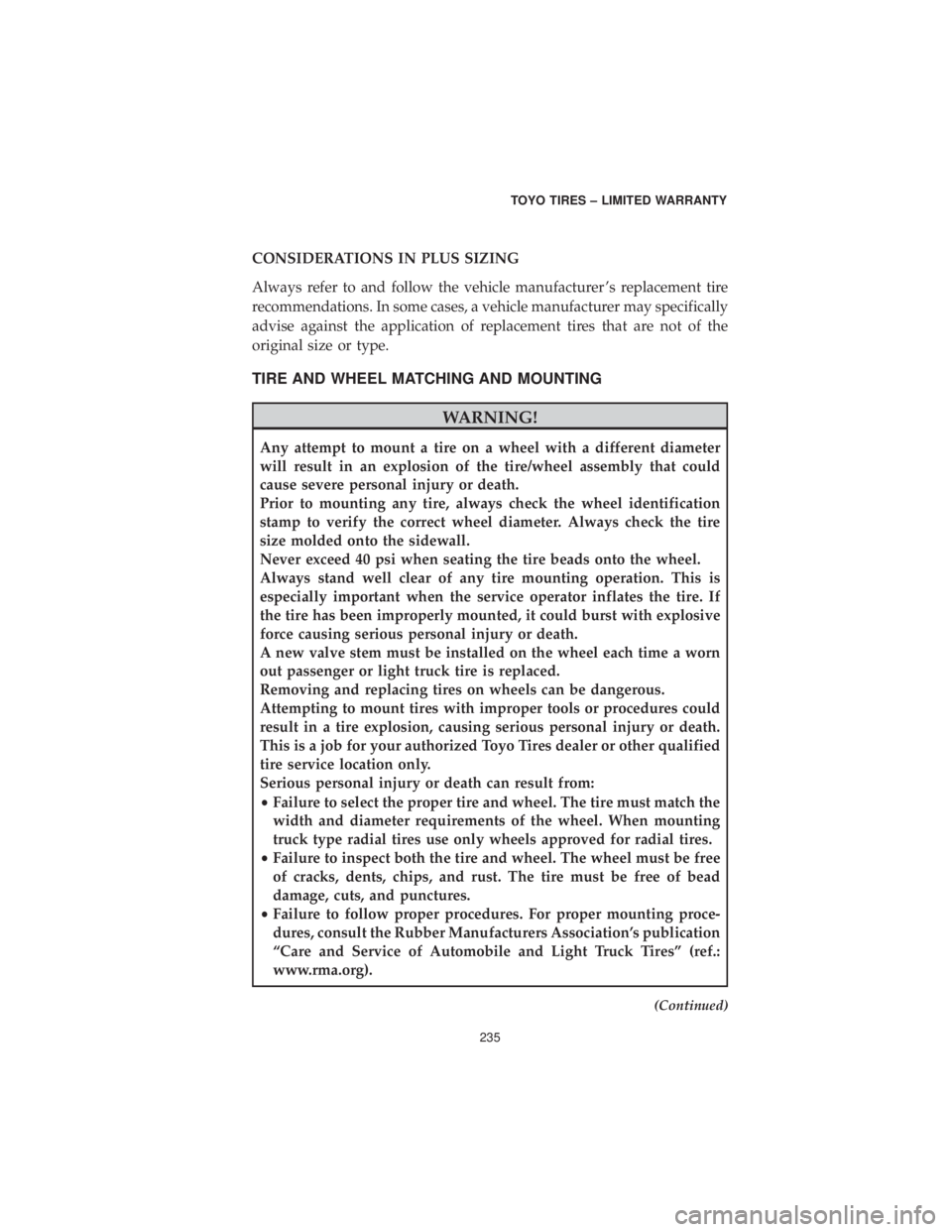
CONSIDERATIONS IN PLUS SIZING
Always refer to and follow the vehicle manufacturer ’s replacement tire
recommendations. In some cases, a vehicle manufacturer may specifically
advise against the application of replacement tires that are not of the
original size or type.
TIRE AND WHEEL MATCHING AND MOUNTING
WARNING!
Any attempt to mount a tire on a wheel with a different diameter
will result in an explosion of the tire/wheel assembly that could
cause severe personal injury or death.
Prior to mounting any tire, always check the wheel identification
stamp to verify the correct wheel diameter. Always check the tire
size molded onto the sidewall.
Never exceed 40 psi when seating the tire beads onto the wheel.
Always stand well clear of any tire mounting operation. This is
especially important when the service operator inflates the tire. If
the tire has been improperly mounted, it could burst with explosive
force causing serious personal injury or death.
A new valve stem must be installed on the wheel each time a worn
out passenger or light truck tire is replaced.
Removing and replacing tires on wheels can be dangerous.
Attempting to mount tires with improper tools or procedures could
result in a tire explosion, causing serious personal injury or death.
This is a job for your authorized Toyo Tires dealer or other qualified
tire service location only.
Serious personal injury or death can result from:
•Failure to select the proper tire and wheel. The tire must match the
width and diameter requirements of the wheel. When mounting
truck type radial tires use only wheels approved for radial tires.
• Failure to inspect both the tire and wheel. The wheel must be free
of cracks, dents, chips, and rust. The tire must be free of bead
damage, cuts, and punctures.
• Failure to follow proper procedures. For proper mounting proce-
dures, consult the Rubber Manufacturers Association’s publication
“Care and Service of Automobile and Light Truck Tires” (ref.:
www.rma.org).
(Continued)
TOYO TIRES – LIMITED WARRANTY
235
Page 237 of 270
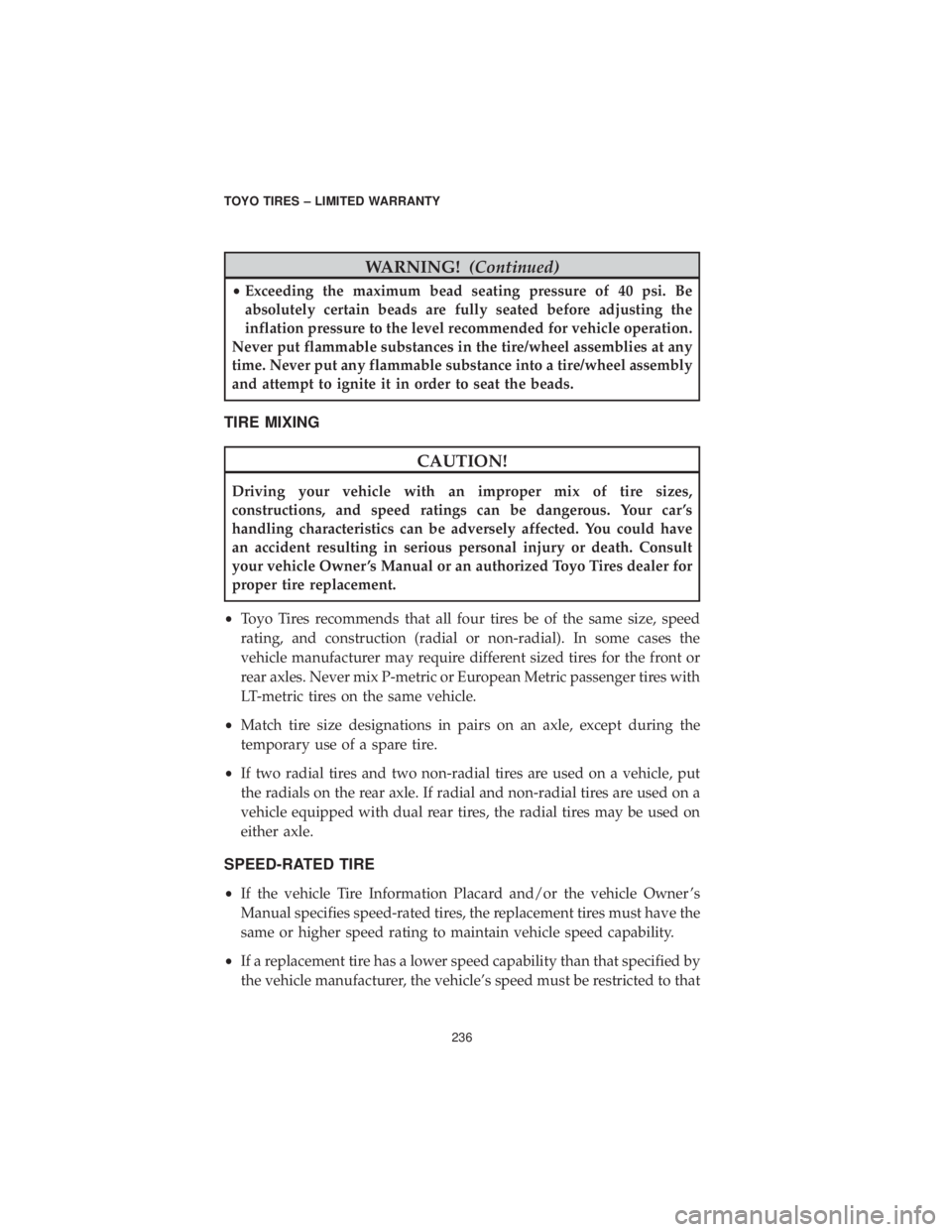
WARNING!(Continued)
•Exceeding the maximum bead seating pressure of 40 psi. Be
absolutely certain beads are fully seated before adjusting the
inflation pressure to the level recommended for vehicle operation.
Never put flammable substances in the tire/wheel assemblies at any
time. Never put any flammable substance into a tire/wheel assembly
and attempt to ignite it in order to seat the beads.
TIRE MIXING
CAUTION!
Driving your vehicle with an improper mix of tire sizes,
constructions, and speed ratings can be dangerous. Your car ’s
handling characteristics can be adversely affected. You could have
an accident resulting in serious personal injury or death. Consult
your vehicle Owner ’s Manual or an authorized Toyo Tires dealer for
proper tire replacement.
• Toyo Tires recommends that all four tires be of the same size, speed
rating, and construction (radial or non-radial). In some cases the
vehicle manufacturer may require different sized tires for the front or
rear axles. Never mix P-metric or European Metric passenger tires with
LT-metric tires on the same vehicle.
• Match tire size designations in pairs on an axle, except during the
temporary use of a spare tire.
• If two radial tires and two non-radial tires are used on a vehicle, put
the radials on the rear axle. If radial and non-radial tires are used on a
vehicle equipped with dual rear tires, the radial tires may be used on
either axle.
SPEED-RATED TIRE
• If the vehicle Tire Information Placard and/or the vehicle Owner ’s
Manual specifies speed-rated tires, the replacement tires must have the
same or higher speed rating to maintain vehicle speed capability.
• If a replacement tire has a lower speed capability than that specified by
the vehicle manufacturer, the vehicle’s speed must be restricted to that
TOYO TIRES – LIMITED WARRANTY
236
Page 238 of 270
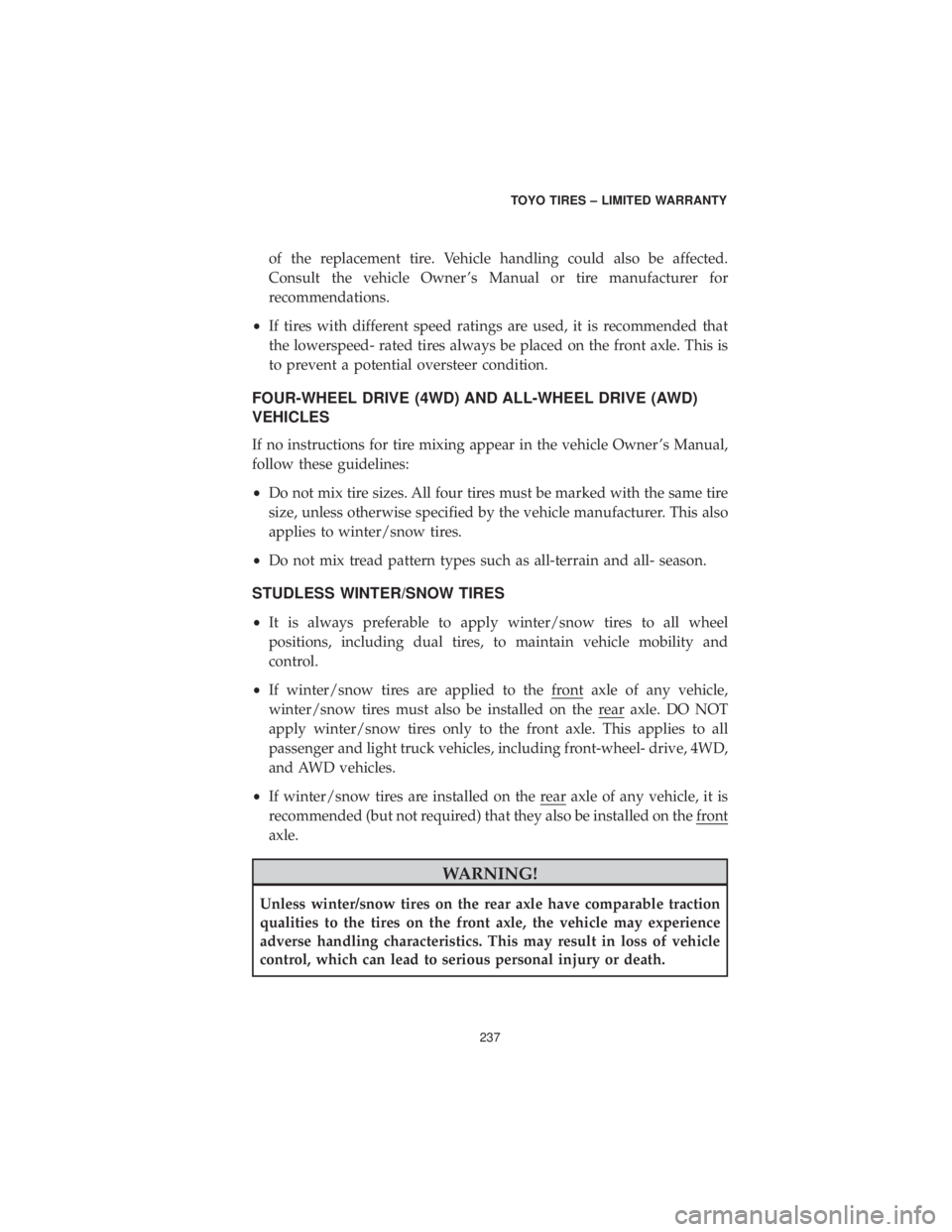
of the replacement tire. Vehicle handling could also be affected.
Consult the vehicle Owner ’s Manual or tire manufacturer for
recommendations.
• If tires with different speed ratings are used, it is recommended that
the lowerspeed- rated tires always be placed on the front axle. This is
to prevent a potential oversteer condition.
FOUR-WHEEL DRIVE (4WD) AND ALL-WHEEL DRIVE (AWD)
VEHICLES
If no instructions for tire mixing appear in the vehicle Owner ’s Manual,
follow these guidelines:
• Do not mix tire sizes. All four tires must be marked with the same tire
size, unless otherwise specified by the vehicle manufacturer. This also
applies to winter/snow tires.
• Do not mix tread pattern types such as all-terrain and all- season.
STUDLESS WINTER/SNOW TIRES
•It is always preferable to apply winter/snow tires to all wheel
positions, including dual tires, to maintain vehicle mobility and
control.
• If winter/snow tires are applied to the front axle of any vehicle,
winter/snow tires must also be installed on the rear axle. DO NOT
apply winter/snow tires only to the front axle. This applies to all
passenger and light truck vehicles, including front-wheel- drive, 4WD,
and AWD vehicles.
• If winter/snow tires are installed on the rear axle of any vehicle, it is
recommended (but not required) that they also be installed on the front
axle.
WARNING!
Unless winter/snow tires on the rear axle have comparable traction
qualities to the tires on the front axle, the vehicle may experience
adverse handling characteristics. This may result in loss of vehicle
control, which can lead to serious personal injury or death.
TOYO TIRES – LIMITED WARRANTY
237
Page 239 of 270

STUDDED WINTER/SNOW TIRES
•Studded winter/snow tires have higher traction qualities under most
winter weather conditions.
• If studded winter/snow tires are installed on the front axle of any
vehicle, studded winter/snow tires must also be installed on the rear
axle. DO NOT apply studded winter/snow tires only to the front axle.
• If studded winter/snow tires are installed on the rear axle of any
vehicle, it is strongly recommended that they should also be installed
on the front axle. Only if studded winter/snow tires are installed on all
wheel positions of a vehicle will optimum handling characteristics be
achieved.
WARNING!
Installing only two studded winter/snow tires on the front axle of
any vehicle (including front-wheel-drive vehicles) without studded
winter/snow tires on the rear axle can cause adverse vehicle
handling characteristics. This can result in a loss of vehicle control,
which could cause serious personal injury or death.
m NOTICE!
In some cases, the vehicle manufacturer may specifically advise against
replacing fewer than all four tires. Always check and follow the
recommendations in the vehicle Owner’s Manual. For 4WD and AWD
vehicles, even small differences in outside diameter may cause drivetrain
damage or mechanical malfunction.
REPLACING TWO TIRES
•When a pair of replacement tires is selected in the same size and
construction as those on the vehicle, the two newer tires must be
installed on the rear axle and must be of equal or higher speed rating
than the front tires. Generally, new tires with deeper tread will provide
better grip and evacuate water more effectively, which is important as
a driver approaches hydroplaning situations. Placing greater traction
on the rear axle on wet surfaces is necessary to prevent a possible
oversteer condition and loss of vehicle stability.
TOYO TIRES – LIMITED WARRANTY
238
Page 241 of 270

TIRE WEAR – VISUAL CHECK
WARNING!
Beware of Sudden Tire Vibration. A tire failure may lead to loss of
vehicle control, which could cause serious personal injury or death.
Many tire failures are preceded by vibration, bumps, bulges, or
irregular wear. If while driving your vehicle you experience any
unusual vibration, pull, ride disturbance, or noise and/or you
suspect possible vehicle or tire damage, do not continue to drive.
(Continued)
TOYO TIRES – LIMITED WARRANTY240
Page 242 of 270
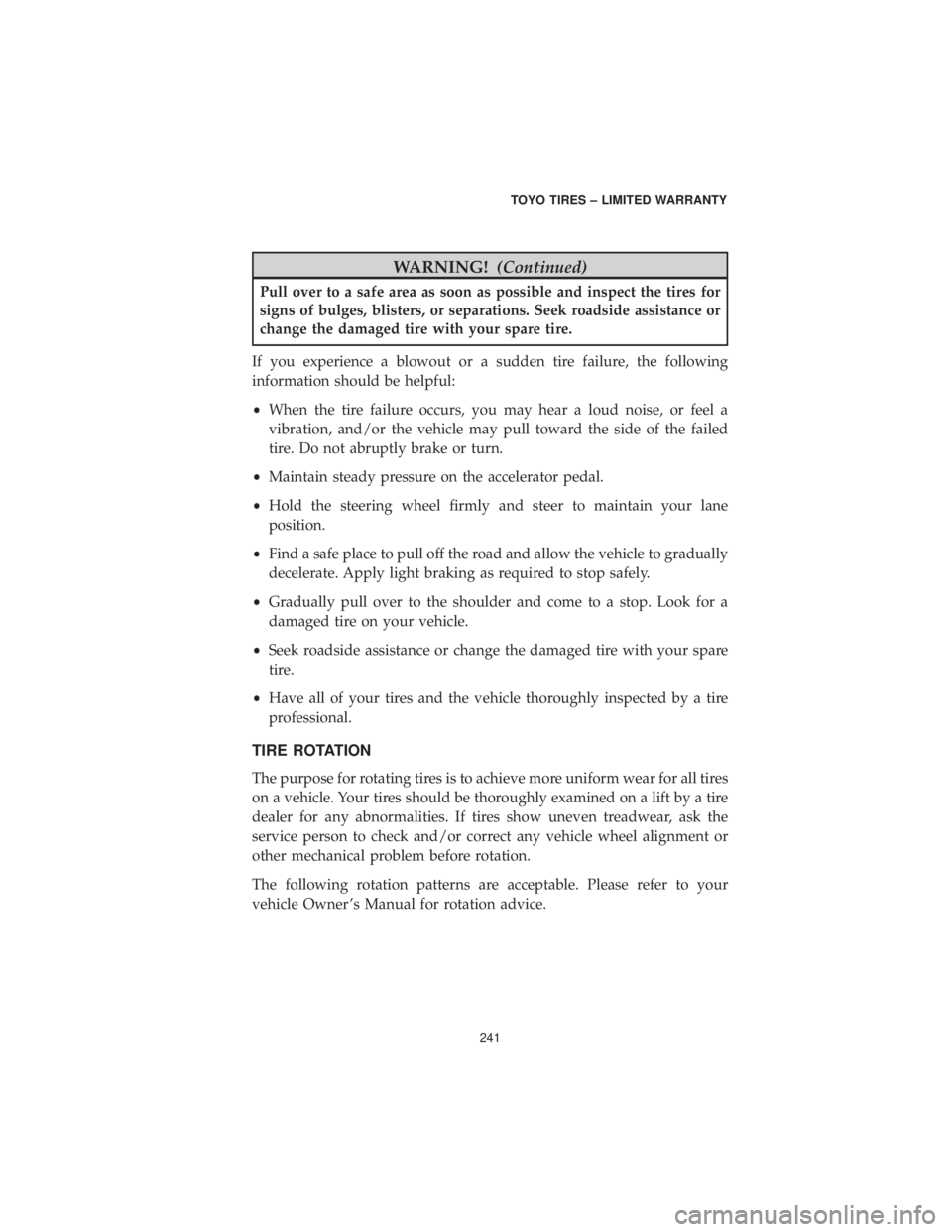
WARNING!(Continued)
Pull over to a safe area as soon as possible and inspect the tires for
signs of bulges, blisters, or separations. Seek roadside assistance or
change the damaged tire with your spare tire.
If you experience a blowout or a sudden tire failure, the following
information should be helpful:
• When the tire failure occurs, you may hear a loud noise, or feel a
vibration, and/or the vehicle may pull toward the side of the failed
tire. Do not abruptly brake or turn.
• Maintain steady pressure on the accelerator pedal.
• Hold the steering wheel firmly and steer to maintain your lane
position.
• Find a safe place to pull off the road and allow the vehicle to gradually
decelerate. Apply light braking as required to stop safely.
• Gradually pull over to the shoulder and come to a stop. Look for a
damaged tire on your vehicle.
• Seek roadside assistance or change the damaged tire with your spare
tire.
• Have all of your tires and the vehicle thoroughly inspected by a tire
professional.
TIRE ROTATION
The purpose for rotating tires is to achieve more uniform wear for all tires
on a vehicle. Your tires should be thoroughly examined on a lift by a tire
dealer for any abnormalities. If tires show uneven treadwear, ask the
service person to check and/or correct any vehicle wheel alignment or
other mechanical problem before rotation.
The following rotation patterns are acceptable. Please refer to your
vehicle Owner ’s Manual for rotation advice.
TOYO TIRES – LIMITED WARRANTY
241